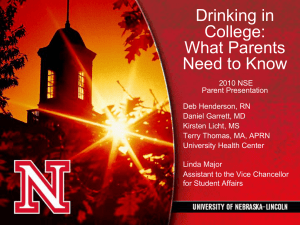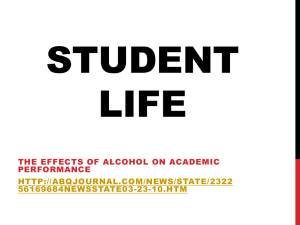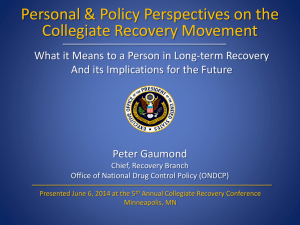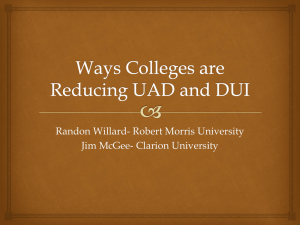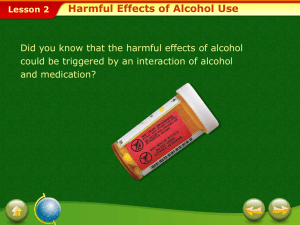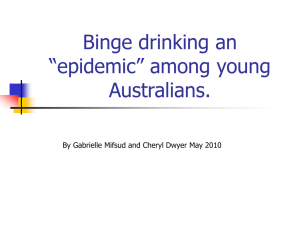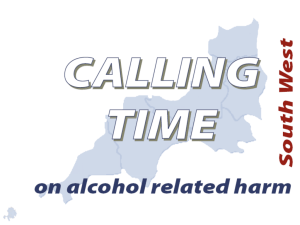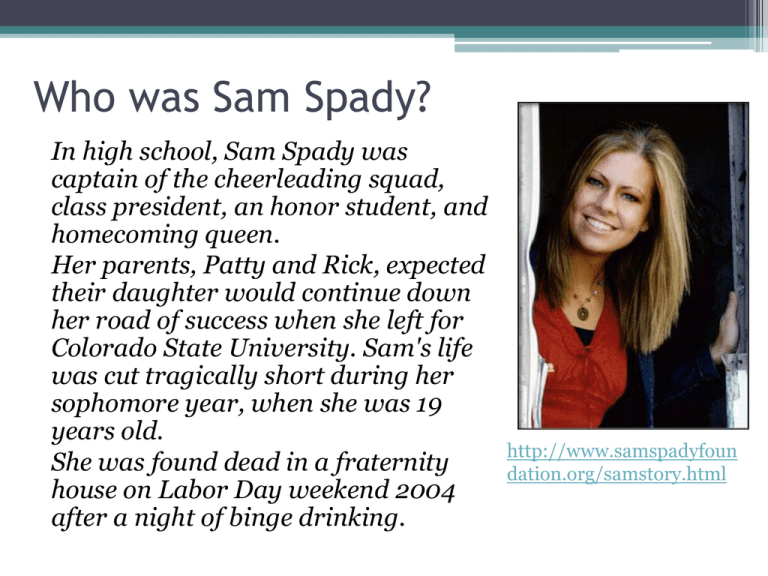
Who was Sam Spady?
In high school, Sam Spady was
captain of the cheerleading squad,
class president, an honor student, and
homecoming queen.
Her parents, Patty and Rick, expected
their daughter would continue down
her road of success when she left for
Colorado State University. Sam's life
was cut tragically short during her
sophomore year, when she was 19
years old.
She was found dead in a fraternity
house on Labor Day weekend 2004
after a night of binge drinking.
http://www.samspadyfoun
dation.org/samstory.html
Binge Drinking 101
9.ATOD.2.2
Use strategies for avoiding binge
drinking.
Objectives
•
•
•
•
•
Define binge drinking
Explore who engages in binge drinking
Discuss risks associated with binge drinking
Review what to do for alcohol poisoning
Create strategies to avoid binge drinking
What is binge drinking?
• The National Institute on Alcohol Abuse and
Alcoholism defines binge drinking as a pattern
of drinking that brings a person’s blood alcohol
concentration (BAC) to 0.08 or above.
• This typically happens when males consume 5 or
more drinks, and when females consume 4 or
more drinks, in about 2 hours.
What is a drink?
• One 12-ounce beer
• One 4- to 5-ounce glass of
wine
• One 1.5-ounce shot of 80proof liquor
All equal one drink.
Who binge drinks?
• Binge drinking often begins around age 13, tends
to increase during adolescence, peak in young
adulthood (ages 18-22), then gradually decrease.
• What are the risks?
• People who binge drink are at much great risk for
many problems…
What is the problem?
• Injury: 599,000 students between the ages of
18 and 24 are unintentionally injured under the
influence of alcohol.
• Assault: 696,000 students between the ages of
18 and 24 are assaulted by another student who
has been drinking.
What is the problem?
• Sexual Abuse: 97,000 students
between the ages of 18 and 24 are
victims of alcohol-related sexual
assault or date rape.
• Unsafe Sex: 400,000 students
between the ages of 18 and 24 had
unprotected sex and more than
100,000 students between the ages
of 18 and 24 report having been too
intoxicated to know if they consented
to having sex .
What is the problem?
• Academic Problems: About 25 percent of college
students report academic consequences of their
drinking including missing class, falling behind,
doing poorly on exams or papers, and receiving lower
grades overall.
• Health Problems/Suicide Attempts: More than
150,000 students develop an alcohol-related health
problem and between 1.2 and 1.5 percent of students
indicate that they tried to commit suicide within the
past year due to drinking or drug use.
• Drunk Driving: 3,360,000 students between the
ages of 18 and 24 drive under the influence of
alcohol.
What is the problem?
• Vandalism: About 11 percent of college student drinkers
report that they have damaged property while under the
influence of alcohol.
• Property Damage: More than 25 percent of
administrators from schools with relatively low drinking
levels and over 50 percent from schools with high drinking
levels say their campuses have a "moderate" or "major"
problem with alcohol-related property damage.
• Police Involvement: About 5 percent of 4-year college
students are involved with the police or campus security as
a result of their drinking, and 110,000 students between
the ages of 18 and 24 are arrested for an alcohol-related
violation such as public drunkenness or driving under the
influence.
What is the problem?
• Alcohol Abuse and Dependence: 31 percent
of college students met criteria for a diagnosis of
alcohol abuse and 6 percent for a diagnosis of
alcohol dependence in the past 12 months,
according to questionnaire-based self-reports
about their drinking.
• Death: 1,825 college students between the ages
of 18 and 24 die from alcohol-related
unintentional injuries, including motor vehicle
crashes.
And…
Did You know?
•Underage drinking can make you act and look stupid.
Alcohol can make you feel more social and daring, but it
actually is a depressant that slows down parts of your brain.
That’s why people who have been drinking behave in ways
they never would while sober.
•Underage drinking makes you accident prone. Alcohol
interferes with your vision, coordination, and concentration
by acting as a sedative on your central nervous system.
Nearly 190,000 12-to 20-year-olds wind up in an emergency
room each year for alcohol-related problems. (The majority
of those who do are male.)
Substance Abuse and Mental Health Services Administration
Center for Substance Abuse Prevention
Did You Know?
Continued
•Underage drinking can harm your brain. The human brain
is not fully developed until the mid-20s. Drinking alcohol, as
with other drugs, can interfere with brain development.
•Underage drinking kills. Every year, about 5,000 young
people under age 21 die as a result of injuries caused by
alcohol use.
•Underage drinking may cause depression or make it
worse. Young people who feel depressed are more likely to
drink alcohol, but alcohol is not a cure for depression. If you
are depressed, ask an adult for help.
Substance Abuse and Mental Health Services Administration
Center for Substance Abuse Prevention
Alcohol Poisoning: Critical Signs
• Mental confusion, stupor, coma, or person
cannot be wakened
• Vomiting
• Seizures
• Slow breathing (fewer than eight breaths per
minute)
• Irregular breathing (10 seconds or more between
breaths)
• Hypothermia (low body temperature), bluish
skin color, paleness
Alcohol Poisoning: What Should I Do?
• If there is any suspicion of an alcohol overdose,
call 911 for help. Don't try to guess the level of
drunkenness.
• Know the danger signals.
• Do not wait for all symptoms to be present.
• Be aware that a person who has passed out may
die.
• Put in recovery position.
Alcohol Poisoning: What Can Happen?
•
•
•
•
•
Victim chokes on his or her own vomit
Breathing slows, becomes irregular, or stops
Heart beats irregularly or stops.
Hypothermia (low body temperature)
Hypoglycemia (too little blood sugar) leads to
seizures
• Untreated severe dehydration from vomiting can
cause seizures, permanent brain damage, or
death
Think, Pair, Share
Write down:
• 3 short-term goals (within the next few months, up to six
months).
• 3 long-term goals (up to five years).
• Your parents or caregivers’ expectations about alcohol use.
• 5-7 reasons underage drinking and binge drinking could be
harmful.
Now…
• What are some potential impacts on your goals with underage
and binge drinking?
• What are some potential impacts on your relationship with
parents or other loved ones with alcohol use?
Finally…
• What skills do you possess to choose not to engage in underage
drinking or binge drinking? (Consider: analyze influences, access
information, communication abilities, positive decision making,
and advocacy)
Questions?


